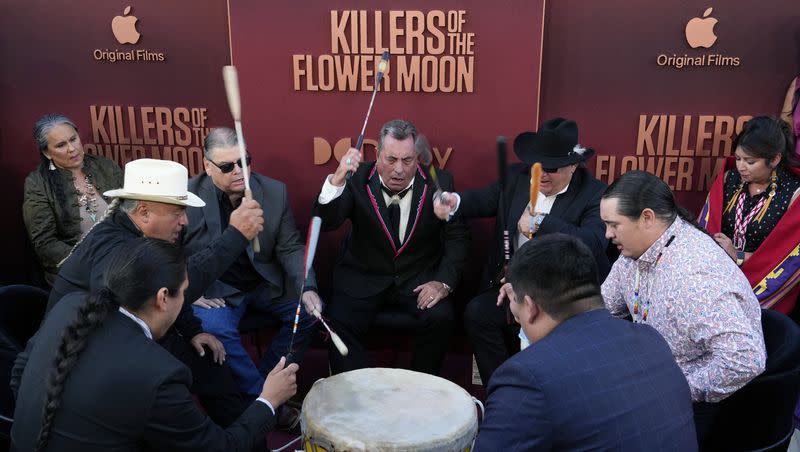The true crime story behind Scorsese’s latest film, ‘Killers of the Flower Moon’

- Oops!Something went wrong.Please try again later.
- Oops!Something went wrong.Please try again later.
“Killers of the Flower Moon” isn’t your average Western — its depiction of love, greed and betrayal is based on a real crime that devastated a community.
The new film tells the story of a series of murders that gripped members of the Osage Nation around 100 years ago. Based on the 2017 nonfiction novel of the same name, “Killers of the Flower Moon” centers on Mollie Kyle, whose family members were among those killed, and her husband, Ernest Burkhart, who played a role in the murders.
What were the Osage murders?
In the early 1920s, at least two dozen people living on or near the Osage Nation Reservation in Oklahoma mysteriously died, according to the FBI.
In May 1921, hunters found the body of Osage woman Anna Brown in a ravine, per The Associated Press. Another member of the tribe was found dead shortly thereafter.
Two months later, Brown’s mother, Lizzie Q. Kyle, died of suspected poisoning, according to the Oklahoma Historical Society. In 1923, Kyle’s nephew, Henry Roan, was shot and killed. A few months later, Lizzie Kyle’s daughter and her husband, Rita and Bill Smith, died when their house was bombed.
Lizzie Q. Kyle’s last living child, Mollie Kyle, began exhibiting symptoms of an illness around the same time. According to the FBI, it was alleged that she was being poisoned.
The Associated Press reported that potentially hundreds of members of the community were murdered, although the exact number is unknown. Despite mounting evidence that someone was targeting members of the Osage Nation, local authorities seemed “indifferent” to the murders, per The Associated Press.
The Osage Nation reached out to the federal government for help, per the FBI. The Bureau of Investigation, as it was called then, was brand-new, but agents assigned to the case quickly zeroed in on a prime suspect.
Why did the Osage murders happen?
The Osage Nation Reservation’s land is rich in oil, and royalties from oil sales made members of the nation quite wealthy in the late 1800s and early 1900s.
According to the Oklahoma Historical Society, each member of the tribe received a “head right,” or an equal share of the royalties. Those head rights could be passed on, and even non-Osage people could inherit them.
The men who were later found responsible for the murders were motivated by a desire to inherit Osage head rights, according to The Associated Press.
“To prevent another ‘Reign of Terror,’ as this dark period in Osage tribal history is often referred, after 1925, federal law prohibited non-Osages from inheriting the head rights of tribal members possessing more than one-half Osage blood,” the Oklahoma Historical Society reports.
Who was responsible for the Osage murders?
Local cattleman William Hale was eventually convicted of orchestrating the murders and was sent to prison along with several others. Notably, his nephew, Ernest Burkhart, who was married to Mollie Kyle, confessed to aiding him.
According to the FBI, Hale was a greedy man who “bribed, intimidated, lied, and stole his way to wealth and power.”
How true to life is the movie?
In any dramatic adaptation of true events, filmmakers take liberties. However, Scorsese and Leonardo DiCaprio, who plays Ernest Burkhart, told CBS they worked with the Osage Nation in order to tell their story as truthfully as possible.
“We did our absolute best to listen to the Osage community,” DiCaprio said. “I don’t know if we did a perfect job. ... But they embraced us and were so incredibly helpful and so vulnerable.”
“Killers of the Flower Moon” is out in theaters Oct. 20.

